For heritage soap making, you'll find seven exceptional plant dyes that create stunning natural colors. Madder root delivers rich crimson hues, while calendula petals infuse golden tones. Indigo leaf produces deep blues, and alkanet root offers purple to burgundy shades. Turmeric adds vibrant yellow notes, and annatto seeds create warm orange-gold variations. Clay-plant combinations round out your natural palette with earthy blends. Discovering these traditional colorants opens up a world of soap crafting possibilities.
Madder Root: Creating Rich Crimson Hues
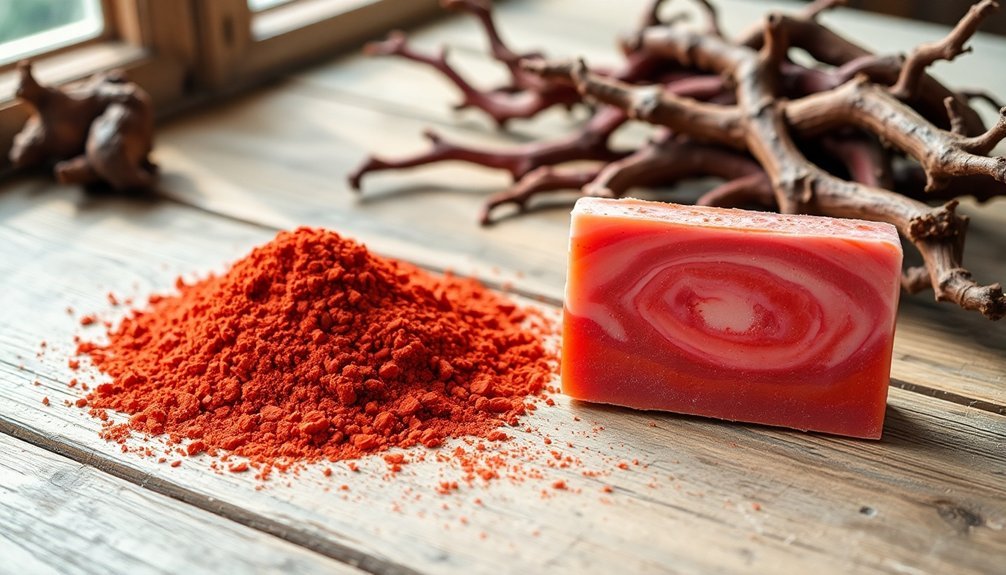
When seeking a natural way to achieve vibrant crimson hues in your soap making, madder root stands out as one of the most reliable plant-based dyes. This natural dye, prized since ancient Egyptian times, offers you a spectrum of red-orange to deep crimson colors without relying on synthetic additives.
You'll find that the dyeing process requires careful attention to temperature and water hardness to achieve ideal results.
To intensify your color, you can either increase the amount of plant material or implement multiple dipping techniques. While madder root works exceptionally well with protein fibers, you'll still achieve beautiful results in your soap making ventures.
The versatility of this historical dye lets you create varying shades of vibrant colors, making it an essential addition to your natural soap-making toolkit.
Calendula Petals: Natural Golden Tones
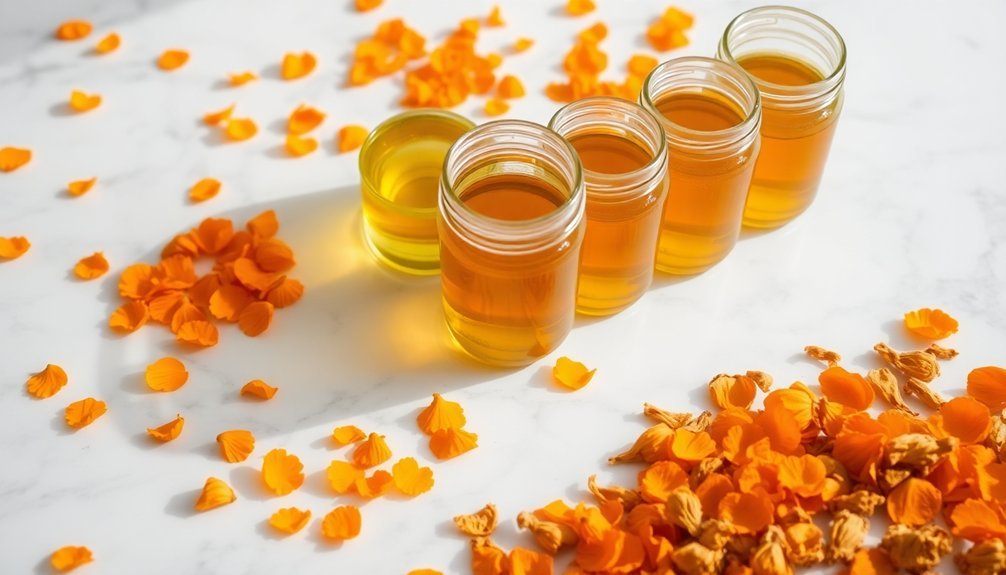
As one of nature's most reliable colorants, calendula petals infuse your soaps with stunning golden hues while maintaining their vibrancy in high pH environments.
Unlike other natural colorants that often fade, these dried plants deliver consistent results in your soap-making projects.
Calendula petals stand out among natural soap colorants, providing dependable golden hues that maintain their beauty batch after batch.
You'll achieve the best results by first creating an infused oil with the petals, which enhances the vibrant golden tones in your final product.
Whether you're sprinkling the petals directly into your soap mixture or using them as a decorative top layer, they'll add both visual appeal and skin care benefits.
For soap makers focused on natural ingredients, calendula petals offer a perfect solution – they're not just beautiful but also beneficial for dry skin.
Their stability in high pH soap makes them an excellent choice for reliable, consistent coloring.
Indigo Leaf: Deep Blue Spectrum
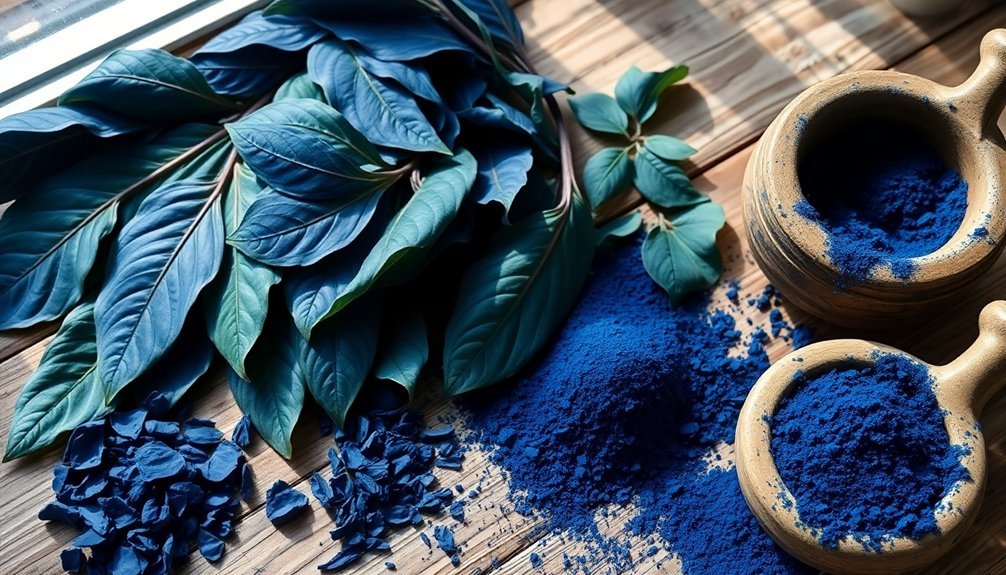
When you're working with fresh indigo leaves for soap dyeing, you'll need to ferment them in an alkaline solution to release their vibrant blue pigments.
You can create a range of blue shades in your soaps by controlling the concentration of the dye and the number of applications during the coloring process.
The traditional oxidation technique involves exposing your soap mixture to air between dye applications, which helps develop and lock in the distinctive indigo blue color.
Preparing Fresh Indigo Leaves
Since fresh indigo leaves hold the key to vibrant blue soap dyes, proper preparation is essential for revealing their full potential.
When you've harvested your fresh plant material, you'll need to begin processing immediately to preserve the indican compound that creates the deep blue hue.
Here's your step-by-step guide to extracting indigo dye for soaping:
- Submerge your freshly harvested leaves in room-temperature water, ensuring they're completely covered.
- Allow the mixture to ferment naturally, which typically takes 24-48 hours.
- Aerate the fermented liquid by stirring vigorously to activate the blue pigment.
- Extract the dye by straining the mixture, leaving you with a concentrated solution.
Achieving Various Blue Shades
Once you've mastered the basic indigo extraction process, you'll discover that achieving different blue shades is remarkably straightforward.
To control the intensity of blue in your handcrafted soaps, adjust the number of dye bath immersions and maintain proper alkaline conditions during fermentation.
You can create a spectrum of blues, from delicate sky blue to rich navy, by carefully managing your dye bath parameters. Start with a single dip for lighter shades, and increase dips gradually for deeper tones.
The key is monitoring pH levels throughout the process, as alkaline conditions are essential for ideal dye absorption.
What makes indigo particularly valuable for soap making is its exceptional lightfastness – your carefully crafted blue shades won't fade over time, ensuring your soaps maintain their beautiful color long after production.
Traditional Oxidation Techniques
Although the art of indigo dyeing spans centuries, mastering traditional oxidation techniques remains crucial for achieving authentic deep blue hues in your soaps.
You'll need to understand how oxidation transforms the dye from its soluble state to its vibrant blue form through proper air exposure.
When working with traditional indigo dyeing methods, consider these key aspects:
- Create a fermentation vat using natural reducing agents like molasses to establish the ideal dyeing environment
- Control the oxidation process by carefully timing your soap's exposure to air between dips
- Adjust the depth of color by varying the number of immersions in the dye bath
- Monitor the oxidation phase to guarantee even color development across your handcrafted soaps
These time-tested techniques allow artisans to achieve consistent, lightfast colors that resist fading, making indigo an excellent choice for heritage soap making.
Alkanet Root: Purple to Burgundy Shades
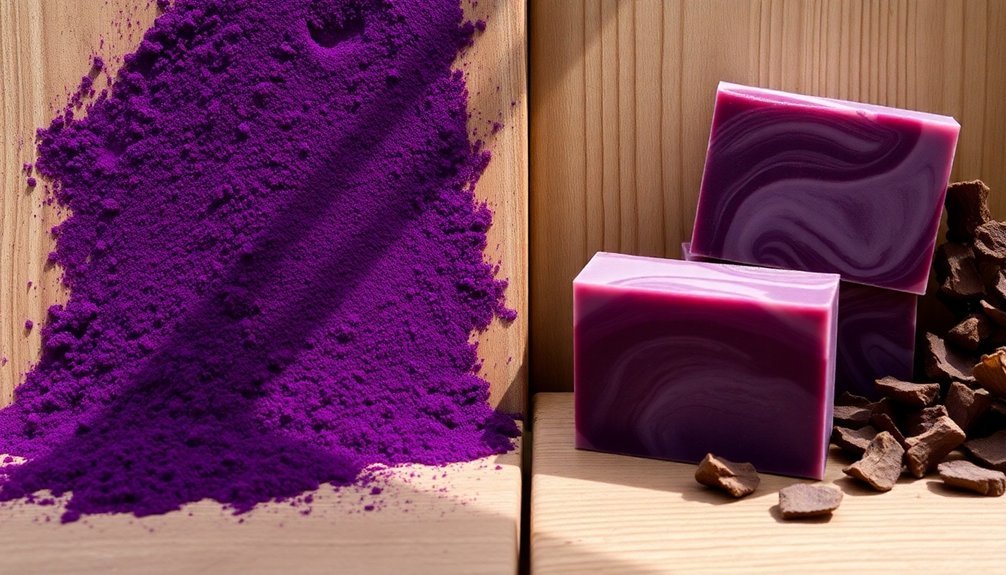
While many natural dyes can be unpredictable, alkanet root stands out as a reliable source for creating stunning purple to burgundy hues in handmade soaps.
You'll find this natural dye particularly effective when you first infuse it in oil, allowing for better integration into your soap making process.
In cold-process soap, you'll witness fascinating color transformations during saponification, with the final shade depending on your mixture's pH level.
The vibrant shades you achieve can range from deep purple to rich burgundy, and you'll notice that darker tones typically maintain their color stability better over time.
Before committing to a large batch, it's smart to test small amounts first, as your specific formulation and ingredient combinations will influence the final color.
This careful approach guarantees you'll achieve the exact shade you're aiming for in your finished soap.
Turmeric Root: Vibrant Yellow Notes
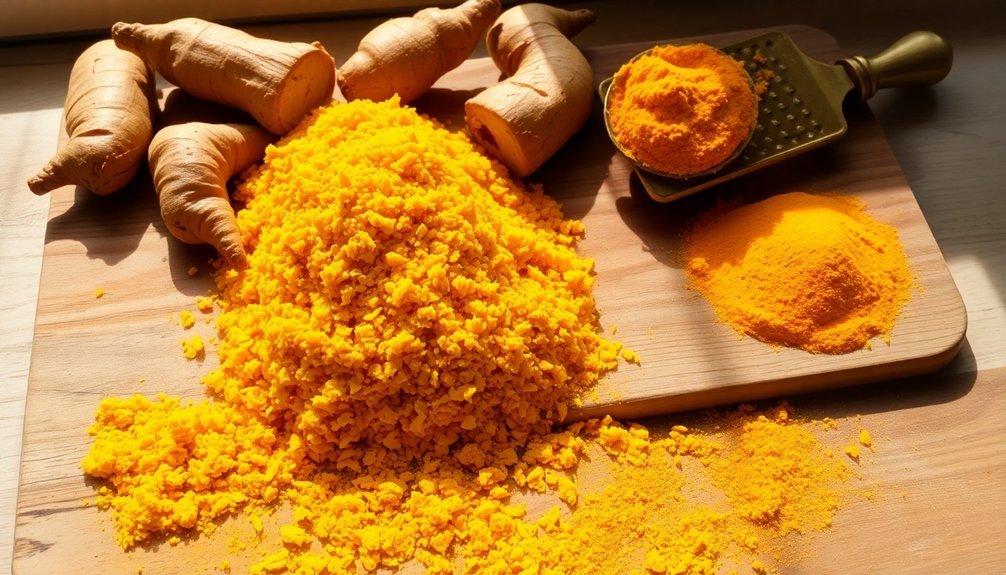
Moving from the deep purples of alkanet root, turmeric brings a stunning range of golden yellows to your soap-making palette. When you're creating natural soap, you'll find turmeric root offers both vibrant yellow hues and valuable skin benefits. For the perfect color soap, mix one teaspoon of turmeric powder per pound of base.
- Creates a rich, golden yellow in cold-process soap that's instantly recognizable
- Offers anti-inflammatory and antioxidant properties for your skin
- Blends easily when mixed with oils before adding lye
- Works best when used fresh, as colors may soften over time
If you're new to soap making with turmeric, start with small batches to perfect your technique. The natural dye's water-soluble properties make it easy to work with, while its therapeutic qualities add extra value to your handcrafted bars.
Annatto Seeds: Orange-Gold Variations
You'll discover that infusing annatto seeds in warm carrier oils creates a range of stunning orange-gold hues for your natural soap colorants.
The process starts with gently heating your chosen oil with the seeds, watching as the color transforms from pale yellow to deep orange over several hours.
The final shade in your soap depends on your infusion time and seed-to-oil ratio, letting you create everything from subtle peachy tones to rich sunset oranges.
Annatto Oil Infusion Methods
When crafting natural soap colorants, annatto seeds offer one of the most reliable and vibrant orange-gold hues through oil infusion.
You'll find this stable color maintains its warmth throughout the saponification process, making it an excellent choice for natural soap making.
You can infuse your carrier oil using two proven methods:
- Cold infusion: Soak seeds at room temperature for 1-2 weeks, allowing natural color extraction
- Hot infusion: Simmer seeds in oil for 30 minutes for quick results
- Standard ratio: Use 1 tablespoon of seeds per cup of carrier oil
- Customization: Adjust the ratio to achieve your desired color intensity
The infused oil you create will add a beautiful warm orange tone to your soap, and you'll appreciate how well it holds its color compared to other natural colorants that might fade over time.
Natural Orange Color Stages
The rich spectrum of orange-gold hues from annatto seeds creates distinct color stages in your soap-making journey.
You'll notice the natural plant dye's intensity varies markedly based on your extraction method and seed quantity. When you soak annatto in oil, you'll achieve deeper, more vibrant oranges compared to water-based extractions.
In your heritage soap-making process, you'll observe how the orange color develops differently as you adjust your seed-to-liquid ratio.
Start with small test batches to understand the dyeing progression, as the final shade can lighten in cold-process soaps due to alkalinity.
Remember that each batch might show slight variations, so documenting your results helps maintain consistency.
Through careful testing, you'll master the art of achieving your desired orange-gold tones in your handcrafted soaps.
Clay-Plant Combinations: Earthy Color Blends
Crafting unique soap colors becomes more versatile by combining natural clays with plant-based dyes. When you blend colorants like French pink, green, or Cambrian blue clay with plant materials, you'll create stunning earthy color blends that remain stable throughout the soapmaking process.
These clay-plant combinations offer multiple benefits for your handcrafted soaps:
- Natural clays act as texture enhancers while providing gentle exfoliation
- Plant materials like calendula and alkanet root intensify vibrant hues
- The alkaline environment of soap supports color stability when using clays
- Clay additions create a rustic aesthetic while conditioning skin
Remember to test small batches first to verify your chosen combinations maintain their beauty during saponification.
You'll discover that clays not only contribute to color but also enhance your soap's overall appeal and effectiveness.
Frequently Asked Questions
What Is the Best Dye for Soap?
You'll get the best soap colors using plant-based dyes like madder root for red-orange, turmeric for yellow, and alkanet root for purple. They're natural and vibrant, but don't exceed 5% of total soap weight.
What Are the Natural Dyes From Plants for Soap?
You'll find natural soap dyes in onion skins for golden yellow, madder root for red-orange, alkanet root for purple, and turmeric for bright yellow. Calendula petals work well too, keeping their color in soap.
What Herbs Are Good for Coloring Soap?
You'll get vibrant colors using calendula for orange-yellow, madder root for pink, alkanet root for purple, and turmeric for bright yellow. Annatto seeds work great too – just infuse them in oils before soapmaking.
What Are the Best Natural Pigments for Soap?
You'll get vibrant results using madder root for reds, turmeric for yellows, and alkanet root for purples. French clays and calendula petals also provide stable, natural coloring for your handmade soaps.
In Summary
You'll find these seven plant dyes offer endless possibilities for creating unique, heritage-inspired soaps. Whether you're drawn to madder's deep reds or indigo's mesmerizing blues, each natural pigment brings its own character to your creations. Don't be afraid to experiment with different combinations and concentrations. Start with single colors, then advance to blending multiple dyes to develop your signature soap palette.

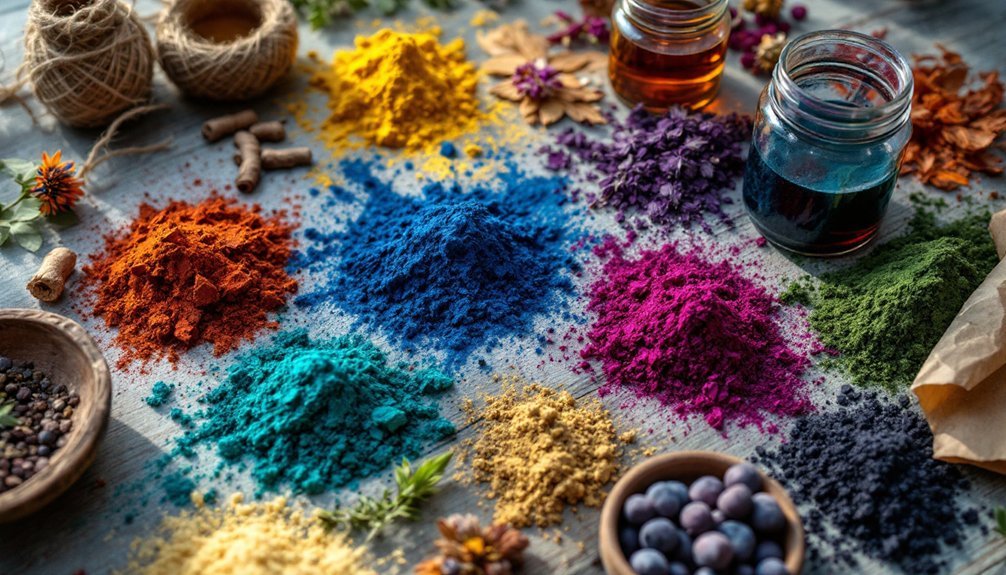



Leave a Reply